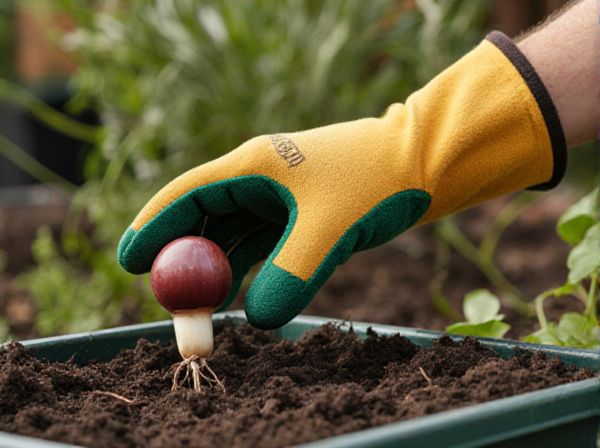
Bulb planter vs dibber Illustration
A bulb planter features a hollow cylindrical design that efficiently removes soil plugs for planting bulbs with consistent depth, ensuring uniform growth. In contrast, a dibber is a pointed tool ideal for creating small holes for seeds or seedlings but lacks the depth control offered by a bulb planter. Choosing between the two depends on whether precise planting depth or versatility for smaller seeds is the priority in gardening tasks.
Table of Comparison
| Feature | Bulb Planter | Dibber |
|---|---|---|
| Purpose | Creates uniform holes for planting bulbs | Makes small holes for seeds or seedlings |
| Design | Tubular metal tube with a handle | Pointed wooden or metal stake |
| Hole Size | Larger, suitable for bulbs | Smaller, for seeds and small plants |
| Mechanism | Scoop out soil core to insert bulb | Pierce soil to create planting hole |
| Best Use | Planting flower or vegetable bulbs | Starting seeds and transplanting seedlings |
| Material | Steel or aluminum tube with wooden/plastic handle | Wood, metal, or plastic |
Bulb Planter vs Dibber: Key Differences Explained
A bulb planter features a hollow cylindrical blade designed for creating uniform holes to plant bulbs efficiently, while a dibber is a pointed tool used for making small holes or indentations for seeds and seedlings. Bulb planters often include a handle for leverage and depth markings for precise planting, whereas dibbers are simpler, handheld tools ideal for delicate or small-scale tasks. Understanding these distinctions helps gardeners select the right tool based on planting depth, soil type, and crop size.
When to Use a Bulb Planter in the Garden
Use a bulb planter in the garden when planting bulbs requires precise hole depth and consistent spacing to ensure optimal growth. Bulb planters are ideal for planting tulips, daffodils, and other spring-flowering bulbs in well-prepared soil with minimal disturbance. This tool is especially useful in larger garden beds where uniform planting depth improves bulb development and promotes healthy roots.
The Advantages of Using a Dibber
A dibber offers precise hole depth control, which is crucial for consistent bulb planting and healthier root systems. Its tapered design allows for easy soil penetration, reducing effort and minimizing disturbance to surrounding plants. Compared to a bulb planter, a dibber is lightweight and multifunctional, making it a versatile tool for gardeners focusing on small-scale bulb planting and seed placement.
Planting Depth and Precision: Which Tool Wins?
Bulb planters excel in planting depth by offering consistent hole sizes and depths, typically adjustable between 2 to 6 inches, ensuring uniform planting essential for bulb growth. Dibbers provide greater precision for small seeds or seedlings with their pointed ends, allowing gardeners to create exact holes at variable depths based on manual control, often less consistent than bulb planters. For depth uniformity and efficiency, bulb planters generally win, while dibbers offer superior precision for delicate planting tasks.
Efficiency and Speed: Comparing Bulb Planters and Dibbers
Bulb planters offer greater efficiency and speed by creating uniform, clean holes with minimal soil disruption, ideal for planting multiple bulbs quickly. Dibbers require more manual effort and time, as they rely on twisting or pushing to make holes, which may vary in depth and size. For large-scale gardening tasks, bulb planters significantly reduce planting time compared to dibbers.
Best Bulb Planters for Beginner Gardeners
The best bulb planters for beginner gardeners offer ergonomic handles and sharp edges to easily penetrate soil, ensuring efficient planting of bulbs without excessive effort. Unlike dibbers, which are primarily designed for making holes, bulb planters often feature depth markers and wider diameters to accommodate various bulb sizes, making them more versatile for novice gardeners. Choosing a durable, rust-resistant bulb planter with a comfortable grip can significantly improve planting accuracy and overall gardening experience for beginners.
Dibber Types and Their Common Uses
Dibbers come in various types including wooden, metal, and plastic, each suited for different soil conditions and planting needs. Wooden dibbers are ideal for softer soils and delicate bulbs, metal dibbers offer durability for tougher ground, and plastic dibbers provide lightweight convenience for general gardening. Gardeners commonly use dibbers to create precise holes for bulbs, seeds, and seedlings, ensuring proper depth and spacing.
Soil Types: Which Tool Performs Better?
Bulb planters perform better in loose, well-draining soils where their cylindrical design allows for clean, uniform holes ideal for bulb planting. Dibbers excel in compact, clay-heavy soils because their pointed tip penetrates hard ground more easily, minimizing soil disturbance while creating precise planting spots. Choosing between a bulb planter and a dibber depends largely on soil texture and consistency, ensuring optimal planting results in different soil types.
Maintenance and Durability: Bulb Planter vs Dibber
Bulb planters typically feature sturdy metal construction with wooden or plastic handles, requiring occasional cleaning and rust prevention to ensure long-term durability. Dibbers, often made from hardwood or metal, demand minimal maintenance but benefit from regular oiling or sanding to prevent splitting or corrosion. Both tools are designed for repetitive soil penetration, with bulb planters generally enduring heavier use due to their robust build compared to the simpler, lighter dibber.
Choosing the Right Tool for Your Planting Needs
Selecting the right tool for your planting needs depends on soil type and bulb size; a bulb planter creates uniform holes quickly in soft to medium soil, ensuring consistent depth for tulips or daffodils. In contrast, a dibber works well for smaller bulbs and seeds, offering precise hole placement in heavier or compacted soils. Understanding these differences helps optimize planting efficiency and promotes healthy root development.
Bulb planter vs dibber Infographic

 gardendif.com
gardendif.com